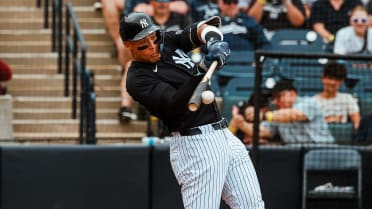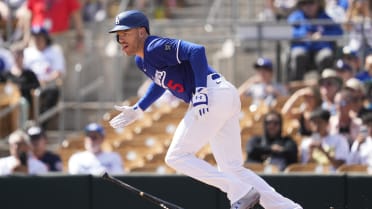Marathon tragedy changed, galvanized Red Sox
BOSTON -- Six months later, the finish line for the 117th Boston Marathon is cracked and peeled, its blue and yellow paint flecked with black. A silent landmark, it is the only obvious evidence that a race took place here, save for a pair of signs on nearby buildings.
One, in the window of a running sneaker store, cites "a huge debt of gratitude to the City of Boston," detailing the rebuilding efforts that followed April's attack on the city. The other, on the second floor of a chiropractic office, depicts a blue and yellow ribbon and the words "Boston Strong."
The Boston Athletic Association, which hosts the marathon, keeps its offices around the corner in a stately brick building just past Copley Square. It was earlier this week that the association's executive director, Tom Grilk, decided to email a group of Red Sox executives, wishing them well against the Cardinals in the World Series.
Barely an hour passed before a reply landed from Red Sox president Larry Lucchino.
"Thank you, Tom," the message read. "As you well know, the Marathon has been with us and our players this entire season. It continues to inspire a nation."
Over the course of a baseball season, successful teams tend to point to specific games, meetings or acquisitions that define their clubs. These Red Sox are different. This group largely points to April 15, the day two bombs exploded near the finish line of the Boston Marathon.
The bombings galvanized a roster composed significantly of free agents, some of them perfect strangers three months prior. Now mowed into Fenway Park's center-field grass, the "Boston Strong" recovery slogan, in the words of outfielder Jonny Gomes, "turned into a lifestyle real quick."
It began when 22 players gathered in Cleveland the night of the bombings, without input from the club, to discuss what they could do to help. As reliever Craig Breslow recalled it, their mission statement revolved around the concept that there is no "right way" to deal with tragedies; the Sox knew only that as public figures, they had the power to influence others.
Today, that influence continues to lace through the lives of many, whose stories have, in turn, come to define the team.
• A sizeable group of victims, rescue people, police and medical types united at Fenway Park earlier this month for a ceremony prior to Game 1 of the American League Division Series. Among them was Robert Wheeler, a marathon finisher who gained fame as the bombings' "shirtless hero." As others ran away from the first explosion, Wheeler hustled toward it, ripping off his jersey to create a makeshift tourniquet for a New Hampshire man's leg.
By October, Wheeler had already reunited and developed a friendship with the man he saved, Ron Brassard, who attended his college graduation at Framingham State. But on the field that night, Wheeler for the first time met a man named Everett Spain, who helped him stop Brassard's bleeding.
What struck Wheeler at Fenway was that his conversations with Brassard, Spain and others tended to skirt around the marathon, focusing instead on the one other topic the men all knew they had in common.
"With anything like that in life, you just talk about other things than this traumatic experience you went through," Wheeler said. "It's more like, 'Hey how about the Sox? How about the way we came back with that grand slam last week?'"
Even so, some conversations did run deeper. Also in attendance that night was Heather Abbott, the Rhode Island woman who lost her left leg as a result of the bombings. One of Fenway Park's ballgirls encountered Abbott for the first time on May 11, moments before she threw out that game's ceremonial pitch. It was the same day Abbott checked out of Boston's Spaulding Rehabilitation Hospital on a wheelchair -- "one of the best days I've had since this whole thing happened," she said, recalling her hop to the mound on crutches. Standing in the middle of the diamond, Abbott could not believe the outpouring of support from her friends, from her family and from the Red Sox. David Ortiz offered some words. Jarrod Saltalamacchia, a hug.
Back at Fenway five months later, the same ballgirl approached Abbott -- now moving without assistance -- to marvel at her improvement.
"The last time she saw me, I was on crutches, having just had my leg amputated," Abbott said. "So she saw me, and I was walking all by myself. She looked at me and pointed to my leg and was just like, 'Oh my gosh!' And I realized how far I had come."
• Between Abbott's two trips to Fenway, the Red Sox busied themselves inviting marathon victims and heroes to throw out first pitches. There was Jeff Bauman, the deli worker who lost both legs cheering on his girlfriend at the race, and Carlos Arredondo, the man who saved his life. (The photograph of Arredondo, in his cowboy hat, helping Bauman into a wheelchair remains one of the day's most arresting images.) There was Peter DiMartino, the transplanted New Yorker who suffered shrapnel damage and tore 90 percent of his left Achilles tendon, and Chris Troyanos, the medical director who helped coordinate rescuers at the bomb site. There was the family of Sean Collier, the MIT police officer killed in the aftermath.
There were also moments of silence, such as the May ceremony for Krystle Campbell, one of three to die in the bombings. There were much louder moments, including the night that 7-year-old Jane Richard, who lost both her left leg and her 8-year-old brother at the marathon, sang the national anthem before a playoff game.
Along the way, there was unbroken support from Yawkey Way.
The Red Sox are not even certain how often players lent their time and services over the past six months, because the players -- and this is not normal -- did not always inform the team before doing so.
"They just started doing it," marveled Lucchino's senior advisor, Charles Steinberg, who counted 470 community appearances that he knew of over the course of the year. Steinberg compared that to the 305 appearances his team made in 2012, with marathon initiatives accounting for much of the difference.
Abbott also noticed a pattern emerge from those numbers. As the Red Sox continued honoring victims and rescuers, the club kept on winning, amassing its second-highest victory total in 35 years. From her home in Newport, R.I., Abbott referred to it as "that Boston Strong mentality" now mowed into the grass, convinced of its role in the Red Sox winning the pennant.
That may seem like an overly romantic notion, particularly from someone outside Fenway's walls. But the players don't dismiss it. To the contrary, they point to their charitable efforts as key bonding moments for a club comprised largely of free agents.
"The best way I could sum it up is, yeah, I think it was a moment in time that enabled us to galvanize in a certain way," manager John Farrell said. "It was an opportunity for our players to understand their importance in this city, what the Red Sox mean to this region."
Now the Red Sox are in the World Series, and a group of Abbott's Yankees-loving friends from Connecticut are pulling for them.
Wheeler is certainly rooting -- "Who doesn't love a Sox game?" he says -- along with so many others throughout the region and the country.
How much impact the Sox had on those folks is impossible to quantify. Harder still is determining how much the bombings' victims and heroes accelerated the team's on-field coalescence.
What became clear over the summer was simply that the influence ran both ways, allowing each side to draw something good from something evil.
"This is not a city that just lets something like that happen, and just backs down," Saltalamacchia said. "It's a city that says, 'All right, I'm going to go about it as hard as I can and make everyone know that nothing affects us.' That's the way this team has been, and the city's been behind us the whole way."
Anthony DiComo is a reporter for MLB.com. Follow him on Twitter @AnthonyDicomo.



